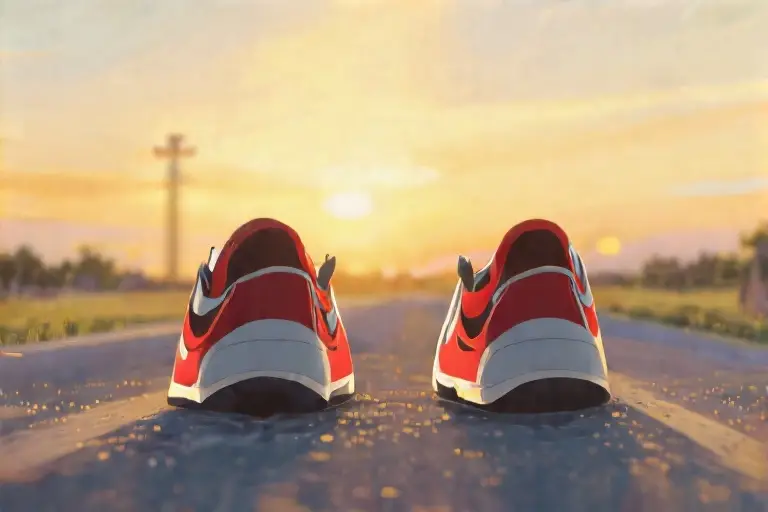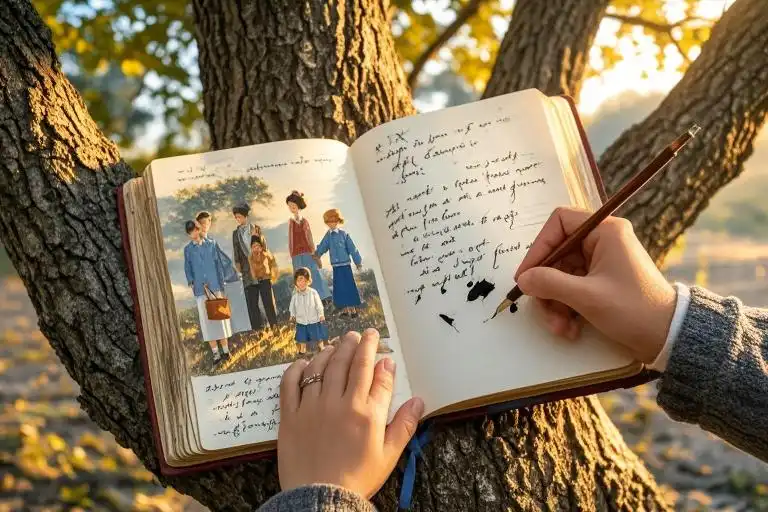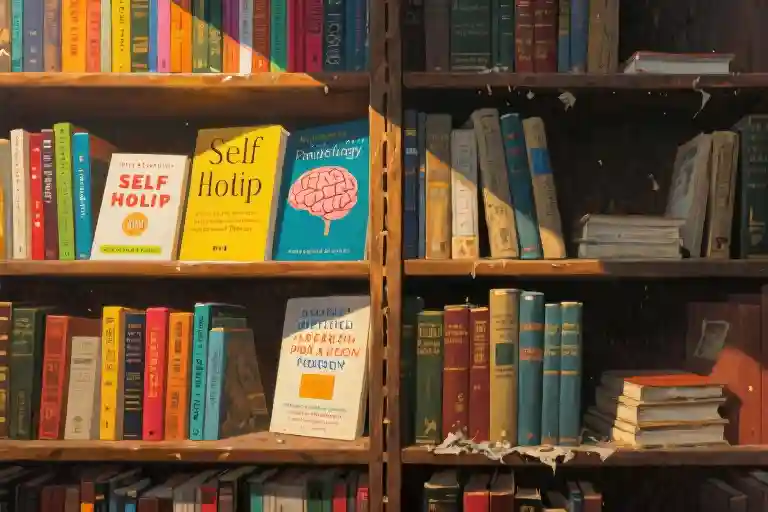The fluorescent lights of the literature building hummed overhead as I clutched my marked-up essay, its margins bleeding red ink. My stomach tightened when I saw that bold, looping ‘C’ at the top – the kind of grade that looked like it had been written with extra enthusiasm, as if my professor wanted to ensure I wouldn’t miss this particular disappointment.
In that moment, I became Ralphie Parker from A Christmas Story, that hopeful kid who imagined his teacher would swoon over his theme paper, awarding it an A++++ with festive flourishes. Reality delivered the same sobering punch: my literary masterpiece (or so I’d thought) had earned the academic equivalent of a participation trophy.
At 26, I was what universities politely call a ‘non-traditional student’ – which really meant I was the mom in sweatpants rushing from preschool drop-off to morning lectures, often with baby wipes still tucked in my purse. After putting my degree on hold to have my daughter, returning to campus felt like reclaiming part of my identity. That is, until Dr. Burda’s red pen reminded me how much I still had to learn about writing in my own native language.
The irony wasn’t lost on me. Here I was, an adult who’d successfully navigated mortgage applications, pediatrician visits, and assembling IKEA furniture without leftover screws – yet properly structuring a thesis statement somehow felt more daunting than deciphering those cryptic Swedish instructions. My academic transcript told the story: while I aced effort, actual writing excellence remained frustratingly out of reach.
Still, I liked Dr. Burda immediately during our first class. He had that rare professorial presence that commanded attention without demanding it, like a character stepped out from a campus novel. When he lectured, his whole body participated – hands conducting imaginary orchestras, voice dipping into different registers for quoted passages. You didn’t just hear Shakespeare from him; you saw the ghost of Hamlet’s father materialize between the PowerPoint slides.
This made my mediocre grade sting differently. A harsh critique from an unremarkable instructor might have been easier to dismiss. But when someone who looked like he’d wandered off the set of Dead Poets Society – complete with tweed jackets that actually had elbow patches – suggests your metaphors ‘land with the grace of expired dairy products,’ you tend to believe him.
What I didn’t know then, shuffling toward his office with my wounded pride, was how that C would become one of my most valuable lessons. Not just about writing, but about being an adult student navigating the gap between life experience and classroom expectations. The red ink wasn’t rejection; it was a roadmap I simply hadn’t learned to read yet.
The Red-Paper Shock
That scarlet letter glared at me from the top margin – a plump, self-satisfied ‘C’ circled twice as if to mock my ambitions. The professor’s red pen had bled across every paragraph, leaving my paper looking like a crime scene. For three sleepless nights, I’d nursed my infant son with one hand and typed this essay with the other, convinced my life experience would translate into academic brilliance.
Reality delivered its verdict in Parker pen ink.
As an adult student returning to college after my parenting hiatus, I’d imagined my hard-won maturity would give me an edge over traditional undergraduates. Changing diapers at 3am certainly built character, but apparently not the kind that impressed literature professors. That ‘fat C’ (as I’d come to think of it) represented more than a grade – it was the collision between my expectations and actual college life for non-traditional students.
I stared at the paper, hearing my baby’s hungry cries echo in memory. Which was harder? Comforting a colicky newborn or crafting the perfect thesis statement? At least with parenting, the messy results were expected and forgiven. Academic work offered no such grace period. The red marks seemed to pulse: You don’t belong here.
Yet beneath the shame simmered reluctant gratitude. Dr. Burda had taken my work seriously enough to demolish it properly. His notes weren’t the vague ‘awkward phrasing’ comments I’d received in high school, but precise surgical strikes: Mixed metaphor here circled with an arrow to Clumsy transition underlined twice. For creative writing students like me, such specific feedback was actually gold – if I could swallow my pride long enough to mine it.
This moment crystallized the unique challenges adult learners face. We bring life experience to the classroom, but often lack the recent academic training. We juggle responsibilities that traditional students don’t, yet receive no grading curve for exhaustion. That ‘C’ represented my first real lesson about balancing parenting and college – expectations need recalibration.
I liked my professor, but…
The Cambridge-Lookalike Professor
Dr. Burda wasn’t just an English professor – he was a walking anachronism, a living literary trope who seemed to have stepped directly out of an Evelyn Waugh novel. His appearance alone taught me more about character description than any creative writing textbook ever could.
The Walking Anachronism
Everything about his physical presence whispered “Oxford don” despite our modest Midwestern campus. The salt-and-pepper hair, forever slightly too long, framed a face that belonged in a Renaissance portrait. His standard uniform – tweed jackets with leather elbow patches over crisp dress shirts – looked perpetually borrowed from a 1970s BBC drama set. The faint scent of pipe tobacco (though I never saw him smoke) and the rhythmic click of his Oxfords on linoleum completed the effect.
As adult students returning to college, we often joked that Dr. Burda single-handedly elevated our community college’s academic credibility by 30%. His sartorial choices weren’t affectation but authenticity – the man genuinely seemed unaware that fashion had evolved since the Nixon administration.
The Performance Artist
His teaching style matched his appearance in theatricality. Lectures became one-man shows where he’d physically act out scenes from Faulkner’s Mississippi or Woolf’s London. I’ll never forget his interpretation of Hemingway’s “Hills Like White Elephants” – by the end, he’d somehow transformed into both the American man and the girl through nothing more than posture and vocal modulation.
That voice. Oh, that voice. It could drop to a conspiratorial whisper during Gothic literature units, then soar to Shakespearean heights during sonnet analysis. When reading Chaucer aloud, he’d adopt a completely believable Middle English accent that made the Canterbury Tales feel immediate rather than ancient.
The Unexpected Domesticity
The most jarring – and therefore memorable – character detail emerged when his wife visited campus. This statuesque blonde German opera singer (twenty years his junior) would arrive carrying his forgotten lunch in delicate porcelain containers. Their dynamic fascinated us – the tweedy academic and the radiant artist exchanging quick German endearments between classes.
This incongruous pairing became my first real-world lesson in complex character development: people contain multitudes. The same professor who dissected Milton with surgical precision would blush like a schoolboy when his wife adjusted his perpetually crooked tie.
The Feedback That Changed Everything
“Your metaphors,” he once told me after class, tapping my latest submission, “are like expired milk – technically accomplishing their purpose but leaving an unpleasant aftertaste.” The critique stung precisely because it came wrapped in that perfect simile. His feedback made me realize creative writing wasn’t about effort alone – it required developing an observant eye and the courage to rewrite.
What began as simple character observations (the way his jacket pockets bulged with scraps of poetry, how he’d absentmindedly conduct imaginary orchestras during particularly musical prose) gradually trained me to see people – and therefore write about them – with greater dimensionality. That C paper ultimately taught me more than any A ever could.
From C to Creative
That red-inked ‘C’ stared back at me like a blinking neon sign announcing my inadequacy. For days, I carried Dr. Burda’s marked-up essay like an embarrassing medical diagnosis, until one morning while making peanut butter sandwiches, I had an epiphany worthy of my toddler’s finger-painting masterpieces – maybe my parenting struggles held the key to better writing.
The Observation Game
Creative writing professors always say ‘show, don’t tell,’ but nobody explains how adult students can develop that skill while juggling real-world responsibilities. Here’s what worked for me:
- The Starbucks Character Sketch (perfect for time-crunched students):
- During my 15-minute coffee breaks, I’d note three physical details about one person (e.g., “Barista’s left eyebrow piercing catches light when she laughs”)
- Later, I’d imagine their backstory using those clues
- Parenting as Metaphor Training:
- Describing my toddler’s tantrums became practice for emotional scenes (“His screams bounced off the walls like rubber balls in an empty gym”)
- Nighttime feedings taught me about pacing (“2 AM silence stretched like taffy until the next wail snapped it”)
Turning Diapers Into Descriptions
Dr. Burda was right about one thing – my early essays read like sterile instruction manuals. But when I started mining my mom-life for material, something shifted. That time my baby projectile-vomited during a job interview? Gold. The playground politics I witnessed? Better than any writing workshop subplot.
Before (Excerpt from my C paper):
“The professor entered the room. He looked academic. Students paid attention.”
After (Revised version):
“Dr. Burda swept in like a Shakespearean actor making his stage entrance, his tweed jacket whispering secrets about Oxford libraries I’d never visit. Even the chronically sleepy football players in back straightened when his voice dropped to that conspiratorial growl he reserved for tragic plot twists.”
The Adult Student Advantage
Research from the National Center for Education Statistics shows that students over 25 often outperform traditional undergraduates in writing-intensive courses – once we stop trying to sound like ‘proper academics.’ Our life experiences become our secret weapon:
- Grocery lists → Sensory detail practice (“avocados that yielded to gentle pressure like a sleeping baby’s cheek”)
- Parent-teacher conferences → Dialogue observation labs
- Medical forms → Precision language drills
Now I see that C not as failure, but as the necessary friction that sparks better writing. My essays will never smell like ivory tower dust, and that’s okay – they carry the sticky fingerprints of real life instead.
An A for Effort
That crimson C glaring from my paper eventually became more than just a grade—it transformed into my most unexpected teacher. While my essays weren’t earning top marks, something far more valuable was happening: I was learning to celebrate progress over perfection. The irony wasn’t lost on me when Professor Burda handed back my final assignment with the note: “Your effort consistently deserves an A, even when your semicolons don’t.”
Adult students returning to college often carry invisible report cards where life experience gets an A+ but academic rust shows. That semester taught me to read between the lines of my transcript. Sure, my character descriptions still occasionally sounded like police reports, and my metaphors sometimes landed with the grace of a toddler on roller skates—but I could now spot these issues myself. Progress, not perfection, became my mantra.
Remember that Ralphie moment from our opening? Here’s the sequel they never filmed: after the initial devastation wears off, you start noticing all the tiny victories. The first time you craft a sentence that actually sings. The moment a classmate asks, “How’d you come up with that description?” The afternoon you realize you’ve been mentally cataloguing people’s quirks like your professor does—the barista’s habit of humming show tunes, your neighbor’s distinctive mailbox-painting ritual.
Creative writing tips often focus on technical skills, but for non-traditional students balancing parenting and college, the real breakthrough comes from self-compassion. That C paper contained more red ink than a teacher’s lounge coffee cup, but it also held my first decent character sketch—a description of my sleep-deprived new-mom self that actually made my professor chuckle. “Now this,” he’d written in the margin, “is observational gold.”
So here’s what I’d tell my younger self clutching that graded paper:
- The gap between effort and outcome is where growth lives
- Life experience becomes writing material when you learn to mine it
- Every creative writing professor secretly loves students who keep trying
My final grade that semester? Let’s just say no one’s optioning this story for an academic thriller. But when I look back at that time—the baby naps spent rewriting paragraphs, the way I started seeing potential stories in grocery store lines—I know what I’d call it: An A for transformation.
What about you? What unexpected lessons did your first academic setback teach you? And more importantly—how are you putting them to work now?





